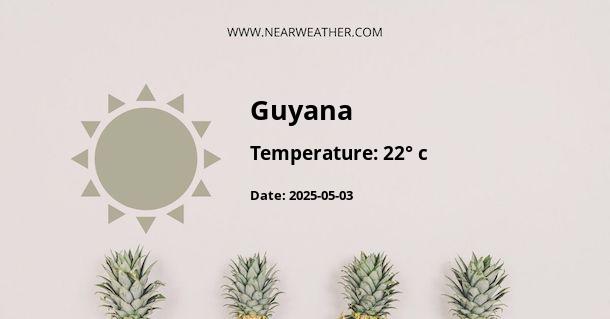Climate and Weather in Guyana
Guyana, officially known as the Co-operative Republic of Guyana, is a country located on the northern mainland of South America. It is bordered by the Atlantic Ocean to the north, Brazil to the south and southwest, Venezuela to the west, and Suriname to the east. The climate in Guyana is heavily influenced by its proximity to the Equator, as well as its diverse topography, including dense rainforests, savannas, and highlands. Guyana experiences a tropical climate characterized by high temperatures, humidity, and significant rainfall throughout the year.
Annual Weather Overview
Guyana experiences two primary seasons: a wet season and a dry season. The wet season typically occurs from May to mid-August, with the peak of rainfall in June and July. The dry season usually spans from mid-August to April. The country's weather is also influenced by the northeast trade winds and the Inter-Tropical Convergence Zone, which contributes to the distribution of rainfall and cloud cover.
Average Temperatures
The average temperatures in Guyana remain relatively constant throughout the year due to its proximity to the Equator. In the coastal regions, temperatures range from 24°C to 31°C (75°F to 88°F). The interior and savannah areas experience slightly higher temperatures, ranging from 26°C to 33°C (79°F to 91°F).
Rainfall
Annual rainfall in Guyana varies across the different regions of the country. The coastal areas receive an average of 2,500 to 3,800 millimeters (98 to 150 inches) of rain per year, while the interior regions receive between 2,000 and 3,000 millimeters (79 to 118 inches) annually. The heavy rainfall is a result of the country's proximity to the Intertropical Convergence Zone and the northeast trade winds.
Humidity
Due to its tropical climate, Guyana experiences high humidity levels throughout the year. Humidity levels range from 70% to 90%, contributing to the warm and muggy conditions experienced across the country.
Climate Variations by Region
While Guyana has a generally consistent tropical climate, there are regional variations due to the country's diverse landscapes. The coastal regions, which comprise approximately 5% of the country's land area, experience the most significant impact from the Atlantic Ocean and the prevailing northeast trade winds. The interior regions, encompassing dense rainforests and savannahs, may experience slightly different weather patterns and temperatures due to their distance from the coast.
Extreme Weather Events
Guyana is susceptible to extreme weather events such as flooding and occasional tropical storms and hurricanes. Heavy rainfall during the wet season can lead to flooding in low-lying coastal areas, while tropical storms and hurricanes pose a threat, particularly during the Atlantic hurricane season from June to November. The country has implemented measures to mitigate the impact of these events, including improved drainage systems and early warning systems.
Best Time to Visit
The best time to visit Guyana is during the dry season, which typically runs from mid-August to April. This period offers favorable weather conditions for exploring the country's diverse natural landscapes, including its rainforests, savannahs, and renowned biodiversity.
Conclusion
Guyana's climate is defined by its tropical conditions, with consistent temperatures, high humidity, and significant rainfall throughout the year. The country's diverse topography contributes to regional variations in weather patterns, making it an intriguing destination for those interested in experiencing the natural wonders of the tropics.
A - Guyana's Latitude is 5.000000 & Longitude is -59.000000.
A - Weather in Guyana is 22° today.
A - Climate Conditions in Guyana shows overcast clouds today.
A - Humidity in Guyana is 99% today.
A - Wind speed in Guyana is 1.69 km/h, flowing at 339° wind direction. today.
